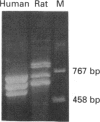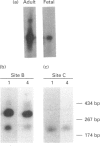Abstract
Plasma-membrane Ca(2+)-pumping ATPases (PMCAs) extrude Ca2+ from the cytoplasm of all cells. Some previous studies of ATP-dependent Ca2+ transport by liver membranes suggested there exist specific properties of the hepatic PMCA, including regulation by hormones which affect calcium signalling. Multiple PMCA isoforms are now known to result from expression of four different genes (known as PMCA 1-4) and alternative RNA splicing at three possible sites (A, B and C). We investigated which isoforms are expressed in adult human and rat liver RNA using reverse-transcription polymerase chain reaction with mixed primers designed to amplify parts of all the known PMCA transcripts. In human liver, products were identified by sequencing from PMCA1, PMCA2 and PMCA4, but not from PMCA3 or from any new gene. In rat liver, by contrast, only PMCA1 and PMCA2 were detectable, although we confirmed that the primers were able to amplify from rat lung a new sequence which is part of rat PMCA4. Of the alternatively spliced variants, at site A in the PMCA2 sequences, all the exons were included in both adult and fetal human liver. In human liver, the exon at site B was excluded in some products from PMCA1 and PMCA4, and at site C, only PMCA1b and one form of PMCA4 were found. Blots of human liver RNA showed PMCA1 and PMCA4 were abundantly expressed, unlike PMCA2. On blots of rat liver RNA, PMCA1 was more abundant than PMCA2, and purified rat parenchymal cell RNA gave similar findings. In summary, no new hepatic PMCA isoforms have been demonstrated, but differences between the predominant human and rat isoforms may have consequences for Ca2+ signalling or the response to liver cell injury.
Full text
PDF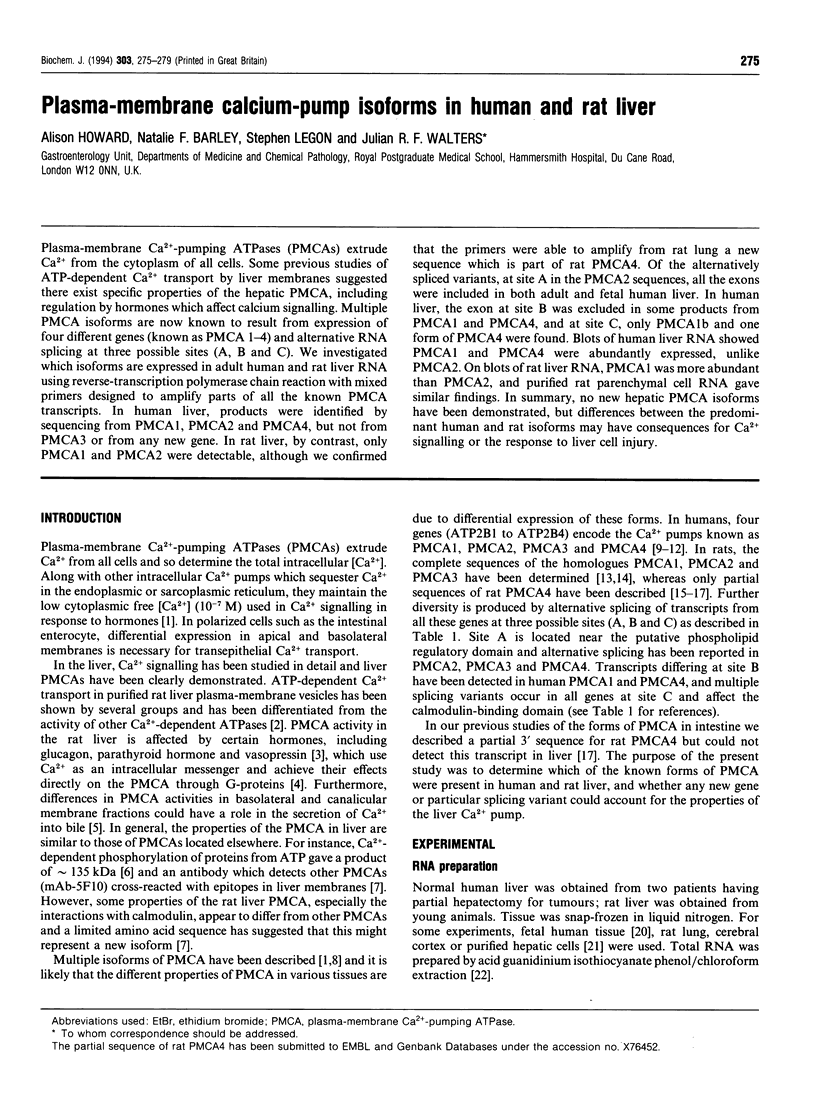
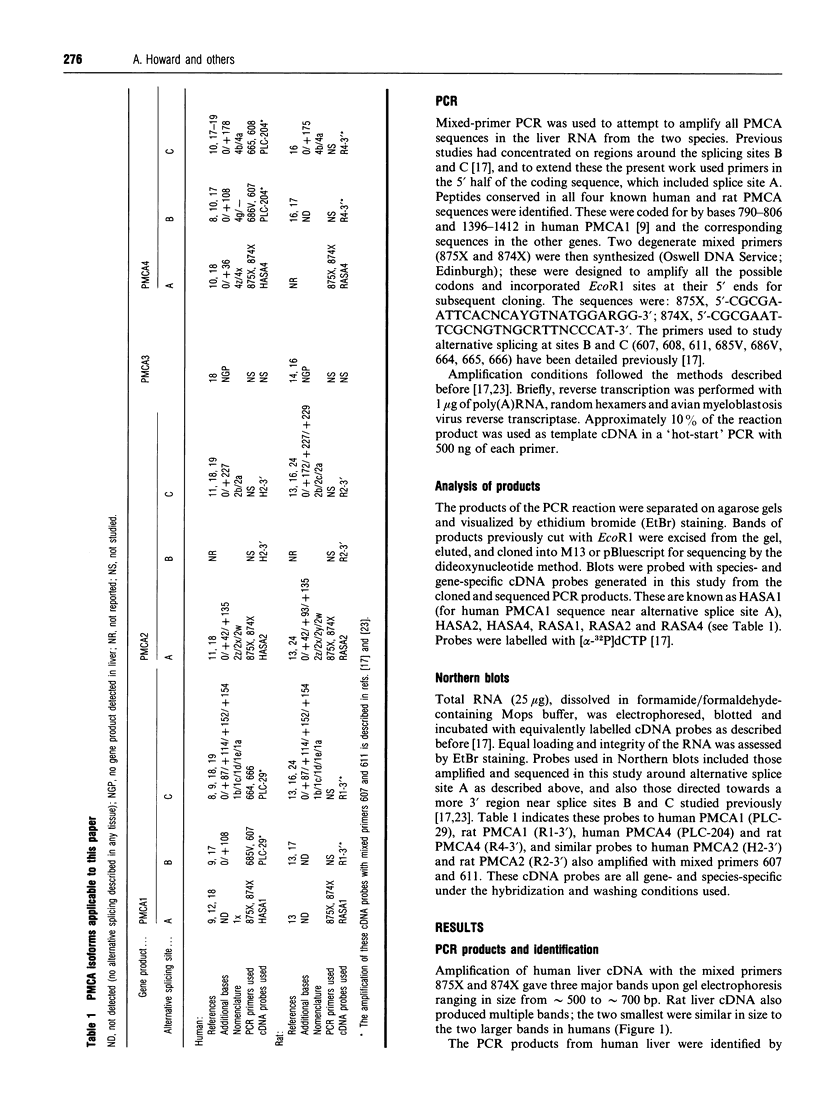
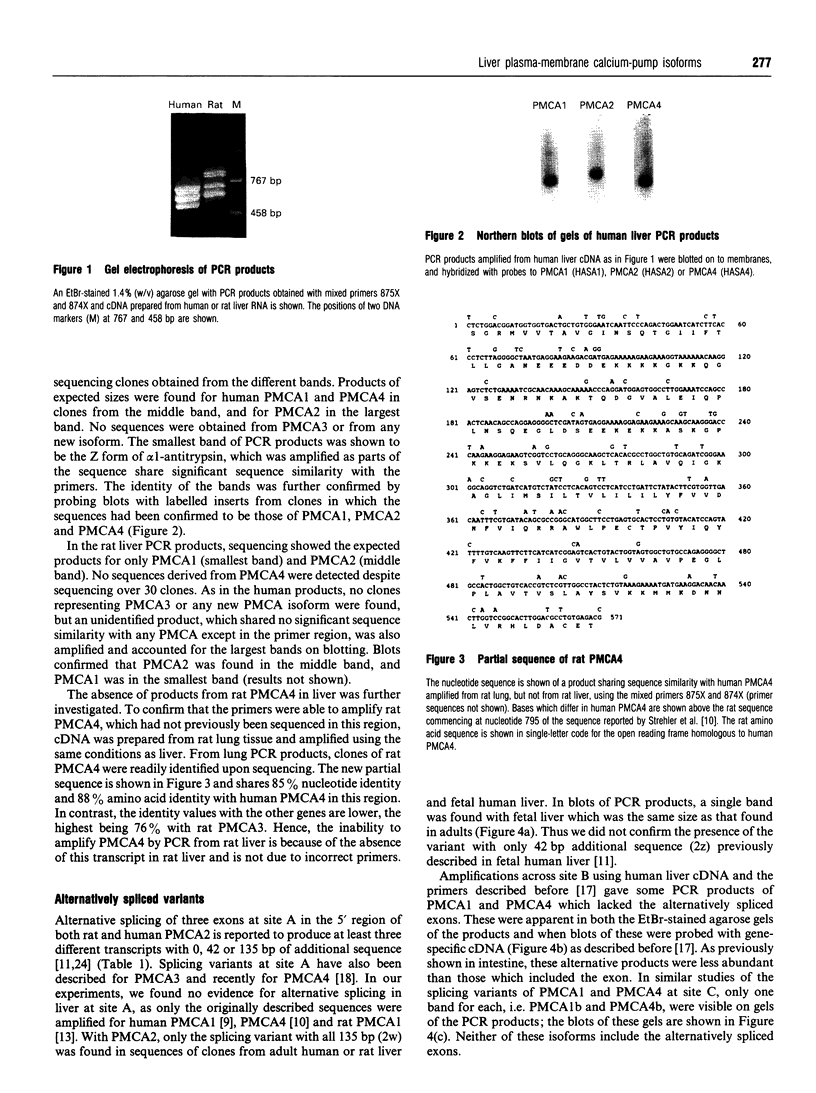
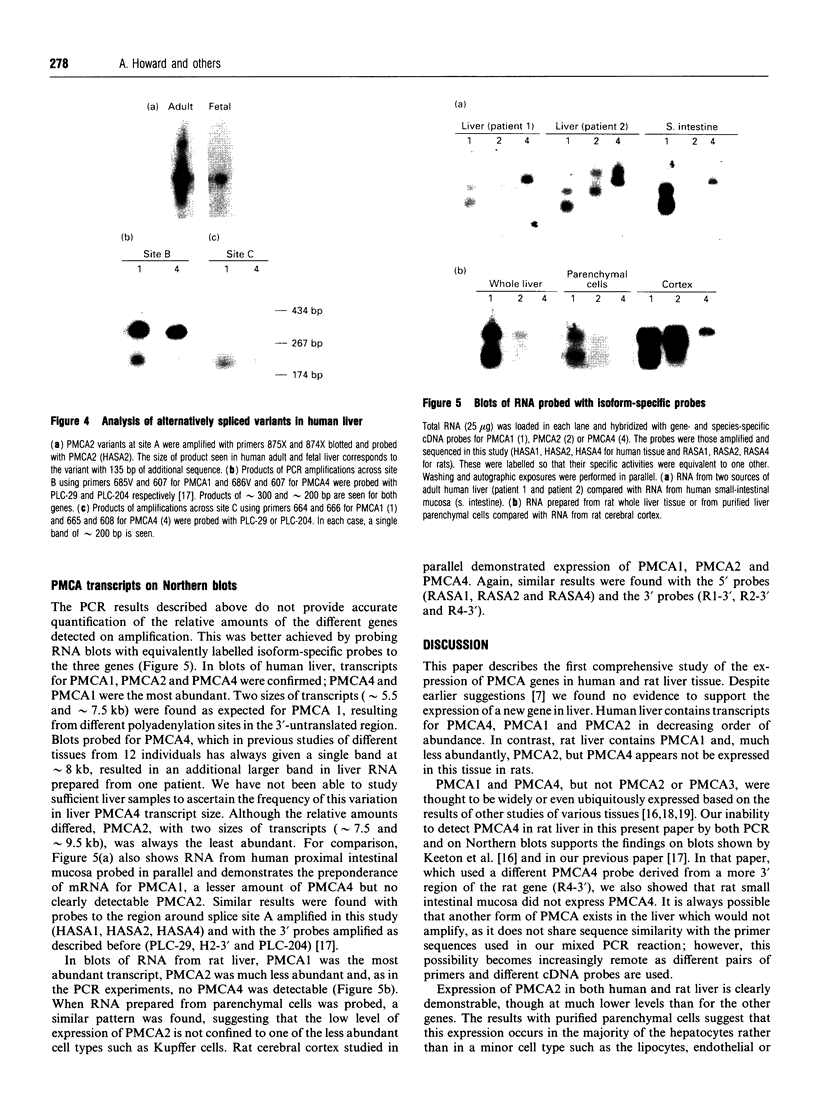
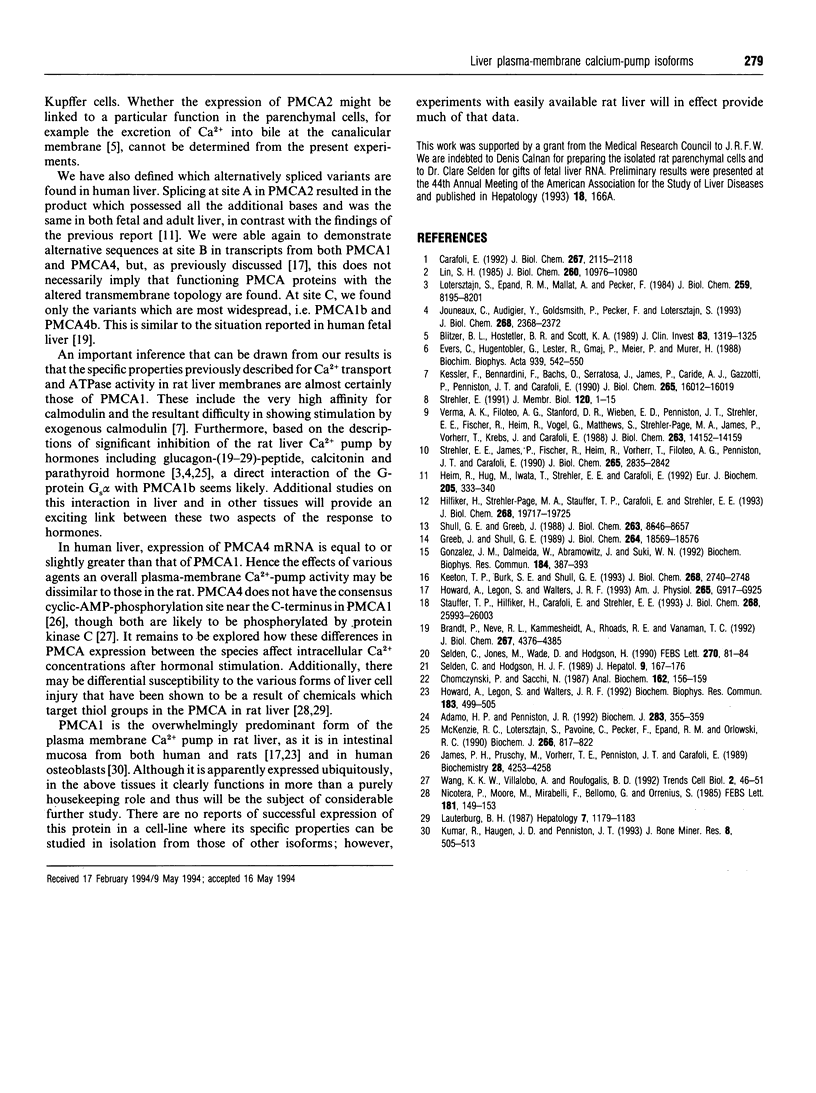
Images in this article
Selected References
These references are in PubMed. This may not be the complete list of references from this article.
- Adamo H. P., Penniston J. T. New Ca2+ pump isoforms generated by alternative splicing of rPMCA2 mRNA. Biochem J. 1992 Apr 15;283(Pt 2):355–359. doi: 10.1042/bj2830355. [DOI] [PMC free article] [PubMed] [Google Scholar]
- Blitzer B. L., Hostetler B. R., Scott K. A. Hepatic adenosine triphosphate-dependent Ca2+ transport is mediated by distinct carriers on rat basolateral and canalicular membranes. J Clin Invest. 1989 Apr;83(4):1319–1325. doi: 10.1172/JCI114018. [DOI] [PMC free article] [PubMed] [Google Scholar]
- Brandt P., Neve R. L., Kammesheidt A., Rhoads R. E., Vanaman T. C. Analysis of the tissue-specific distribution of mRNAs encoding the plasma membrane calcium-pumping ATPases and characterization of an alternately spliced form of PMCA4 at the cDNA and genomic levels. J Biol Chem. 1992 Mar 5;267(7):4376–4385. [PubMed] [Google Scholar]
- Carafoli E. The Ca2+ pump of the plasma membrane. J Biol Chem. 1992 Feb 5;267(4):2115–2118. [PubMed] [Google Scholar]
- Chomczynski P., Sacchi N. Single-step method of RNA isolation by acid guanidinium thiocyanate-phenol-chloroform extraction. Anal Biochem. 1987 Apr;162(1):156–159. doi: 10.1006/abio.1987.9999. [DOI] [PubMed] [Google Scholar]
- Evers C., Hugentobler G., Lester R., Gmaj P., Meier P., Murer H. ATP-dependent Ca2+ uptake and Ca2+-dependent protein phosphorylation in basolateral liver plasma membranes. Biochim Biophys Acta. 1988 Apr 22;939(3):542–550. doi: 10.1016/0005-2736(88)90101-0. [DOI] [PubMed] [Google Scholar]
- Gonzalez J. M., Dalmeida W., Abramowitz J., Suki W. N. Evidence for a fourth rat isoform of the plasma membrane calcium pump in the kidney. Biochem Biophys Res Commun. 1992 Apr 15;184(1):387–393. doi: 10.1016/0006-291x(92)91205-5. [DOI] [PubMed] [Google Scholar]
- Greeb J., Shull G. E. Molecular cloning of a third isoform of the calmodulin-sensitive plasma membrane Ca2+-transporting ATPase that is expressed predominantly in brain and skeletal muscle. J Biol Chem. 1989 Nov 5;264(31):18569–18576. [PubMed] [Google Scholar]
- Heim R., Hug M., Iwata T., Strehler E. E., Carafoli E. Microdiversity of human-plasma-membrane calcium-pump isoform 2 generated by alternative RNA splicing in the N-terminal coding region. Eur J Biochem. 1992 Apr 1;205(1):333–340. doi: 10.1111/j.1432-1033.1992.tb16784.x. [DOI] [PubMed] [Google Scholar]
- Hilfiker H., Strehler-Page M. A., Stauffer T. P., Carafoli E., Strehler E. E. Structure of the gene encoding the human plasma membrane calcium pump isoform 1. J Biol Chem. 1993 Sep 15;268(26):19717–19725. [PubMed] [Google Scholar]
- Howard A., Legon S., Walters J. R. Human and rat intestinal plasma membrane calcium pump isoforms. Am J Physiol. 1993 Nov;265(5 Pt 1):G917–G925. doi: 10.1152/ajpgi.1993.265.5.G917. [DOI] [PubMed] [Google Scholar]
- Howard A., Legon S., Walters J. R. Plasma membrane calcium pump expression in human placenta and small intestine. Biochem Biophys Res Commun. 1992 Mar 16;183(2):499–505. doi: 10.1016/0006-291x(92)90510-r. [DOI] [PubMed] [Google Scholar]
- James P. H., Pruschy M., Vorherr T. E., Penniston J. T., Carafoli E. Primary structure of the cAMP-dependent phosphorylation site of the plasma membrane calcium pump. Biochemistry. 1989 May 16;28(10):4253–4258. doi: 10.1021/bi00436a020. [DOI] [PubMed] [Google Scholar]
- Jouneaux C., Audigier Y., Goldsmith P., Pecker F., Lotersztajn S. Gs mediates hormonal inhibition of the calcium pump in liver plasma membranes. J Biol Chem. 1993 Feb 5;268(4):2368–2372. [PubMed] [Google Scholar]
- Keeton T. P., Burk S. E., Shull G. E. Alternative splicing of exons encoding the calmodulin-binding domains and C termini of plasma membrane Ca(2+)-ATPase isoforms 1, 2, 3, and 4. J Biol Chem. 1993 Feb 5;268(4):2740–2748. [PubMed] [Google Scholar]
- Kessler F., Bennardini F., Bachs O., Serratosa J., James P., Caride A. J., Gazzotti P., Penniston J. T., Carafoli E. Partial purification and characterization of the Ca2(+)-pumping ATPase of the liver plasma membrane. J Biol Chem. 1990 Sep 15;265(26):16012–16019. [PubMed] [Google Scholar]
- Kumar R., Haugen J. D., Penniston J. T. Molecular cloning of a plasma membrane calcium pump from human osteoblasts. J Bone Miner Res. 1993 Apr;8(4):505–513. doi: 10.1002/jbmr.5650080415. [DOI] [PubMed] [Google Scholar]
- Lauterburg B. H. Early disturbance of calcium translocation across the plasma membrane in toxic liver injury. Hepatology. 1987 Nov-Dec;7(6):1179–1183. doi: 10.1002/hep.1840070602. [DOI] [PubMed] [Google Scholar]
- Lin S. H. The rat liver plasma membrane high affinity (Ca2+-Mg2+)-ATPase is not a calcium pump. Comparison with ATP-dependent calcium transporter. J Biol Chem. 1985 Sep 15;260(20):10976–10980. [PubMed] [Google Scholar]
- Lotersztajn S., Epand R. M., Mallat A., Pecker F. Inhibition by glucagon of the calcium pump in liver plasma membranes. J Biol Chem. 1984 Jul 10;259(13):8195–8201. [PubMed] [Google Scholar]
- McKenzie R. C., Lotersztajn S., Pavoine C., Pecker F., Epand R. M., Orlowski R. C. Inhibition of the calcium pump by human parathyroid hormone-(1-34) and human calcitonin in liver plasma membranes. Biochem J. 1990 Mar 15;266(3):817–822. [PMC free article] [PubMed] [Google Scholar]
- Nicotera P., Moore M., Mirabelli F., Bellomo G., Orrenius S. Inhibition of hepatocyte plasma membrane Ca2+-ATPase activity by menadione metabolism and its restoration by thiols. FEBS Lett. 1985 Feb 11;181(1):149–153. doi: 10.1016/0014-5793(85)81131-5. [DOI] [PubMed] [Google Scholar]
- Selden C., Hodgson H. J. Further characterisation of 'hepatotropin', a high molecular weight hepatotrophic factor in rat serum. J Hepatol. 1989 Sep;9(2):167–176. doi: 10.1016/0168-8278(89)90047-0. [DOI] [PubMed] [Google Scholar]
- Selden C., Jones M., Wade D., Hodgson H. Hepatotropin mRNA expression in human foetal liver development and in liver regeneration. FEBS Lett. 1990 Sep 17;270(1-2):81–84. doi: 10.1016/0014-5793(90)81239-k. [DOI] [PubMed] [Google Scholar]
- Shull G. E., Greeb J. Molecular cloning of two isoforms of the plasma membrane Ca2+-transporting ATPase from rat brain. Structural and functional domains exhibit similarity to Na+,K+- and other cation transport ATPases. J Biol Chem. 1988 Jun 25;263(18):8646–8657. [PubMed] [Google Scholar]
- Stauffer T. P., Hilfiker H., Carafoli E., Strehler E. E. Quantitative analysis of alternative splicing options of human plasma membrane calcium pump genes. J Biol Chem. 1993 Dec 5;268(34):25993–26003. [PubMed] [Google Scholar]
- Strehler E. E., James P., Fischer R., Heim R., Vorherr T., Filoteo A. G., Penniston J. T., Carafoli E. Peptide sequence analysis and molecular cloning reveal two calcium pump isoforms in the human erythrocyte membrane. J Biol Chem. 1990 Feb 15;265(5):2835–2842. [PubMed] [Google Scholar]
- Strehler E. E. Recent advances in the molecular characterization of plasma membrane Ca2+ pumps. J Membr Biol. 1991 Feb;120(1):1–15. doi: 10.1007/BF01868586. [DOI] [PubMed] [Google Scholar]
- Verma A. K., Filoteo A. G., Stanford D. R., Wieben E. D., Penniston J. T., Strehler E. E., Fischer R., Heim R., Vogel G., Mathews S. Complete primary structure of a human plasma membrane Ca2+ pump. J Biol Chem. 1988 Oct 5;263(28):14152–14159. [PubMed] [Google Scholar]
- Wang K. K., Villalobo A., Roufogalis B. D. The plasma membrane calcium pump: a multiregulated transporter. Trends Cell Biol. 1992 Feb;2(2):46–52. doi: 10.1016/0962-8924(92)90162-g. [DOI] [PubMed] [Google Scholar]



